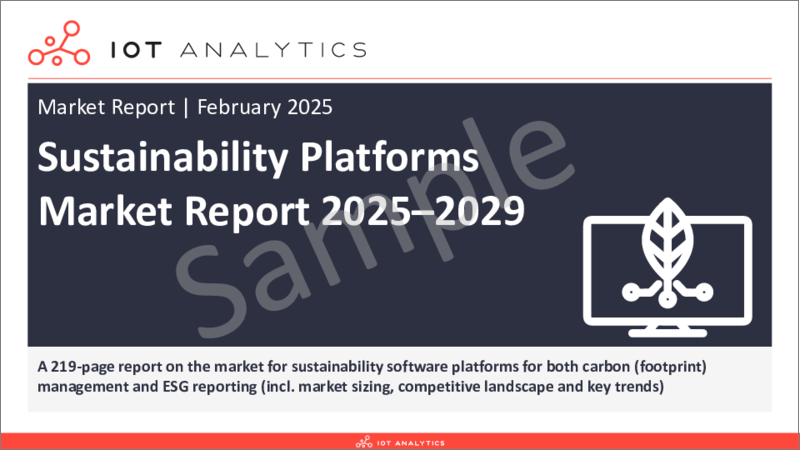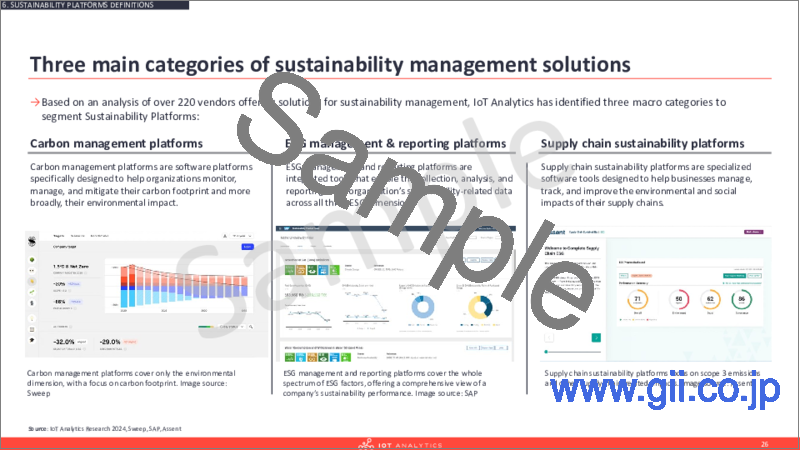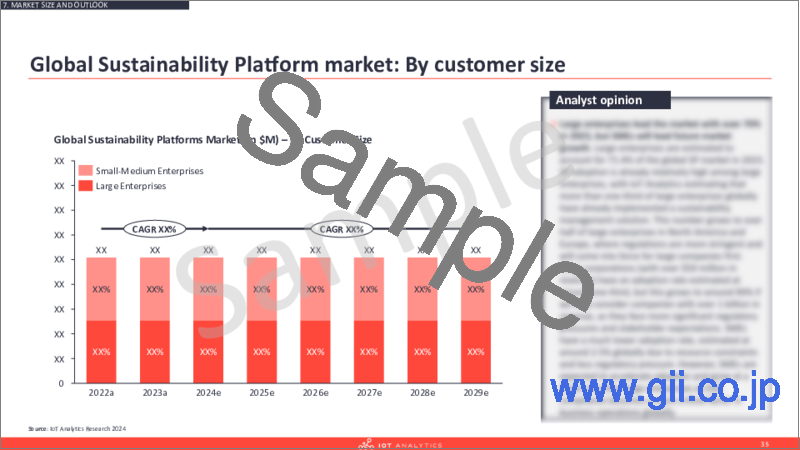|
|
市場調査レポート
商品コード
1651181
持続可能性プラットフォーム市場:2025-2029年Sustainability Platforms Market Report 2025-2029 |
||||||
|
|||||||
| 持続可能性プラットフォーム市場:2025-2029年 |
|
出版日: 2025年02月07日
発行: IoT Analytics GmbH
ページ情報: 英文 219 Pages
納期: 即日から翌営業日
|
全表示
- 概要
- 目次
当レポートでは、持続可能性プラットフォームの市場を調査し、市場の定義、成長促進要因・課題、市場規模の推移・予測、競合情勢、主な動向と展開、ケーススタディなどをまとめています。
サンプルビュー
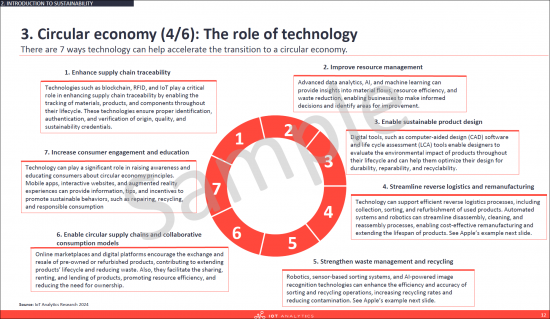
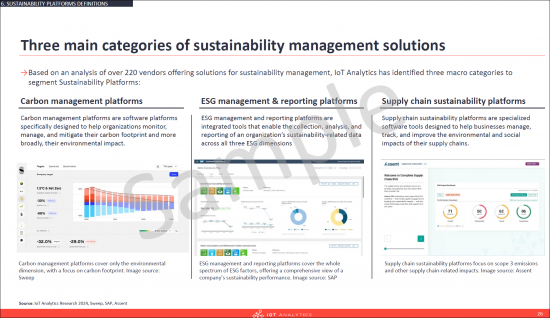
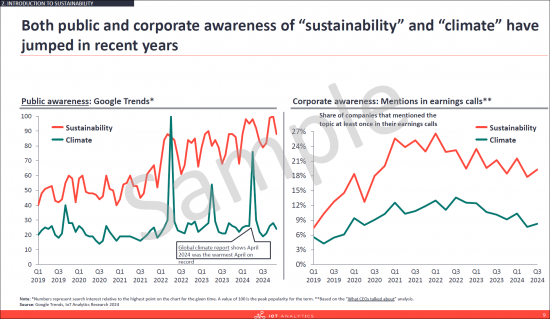
サンプルビュー
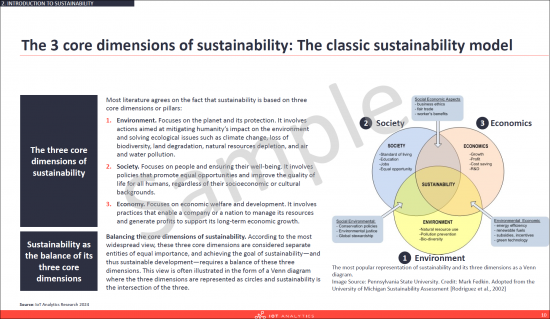
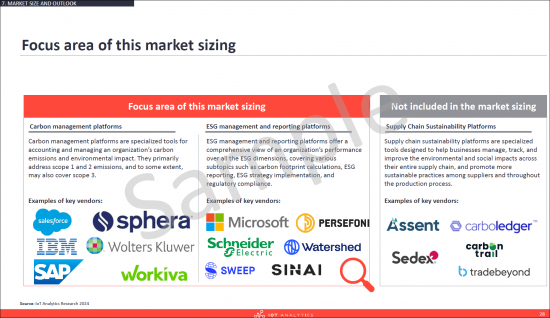
市場について
持続可能性プラットフォームの市場はまだ開発初期段階にありますが、急速に成長しています。ほとんどの導入企業は、まだパイロット段階や小規模な導入にとどまっています。同市場は、8つの主要ベンダータイプに高度に細分化されています。ベンダーは8つのセグメントに分類されています:
|
|
サンプルビュー
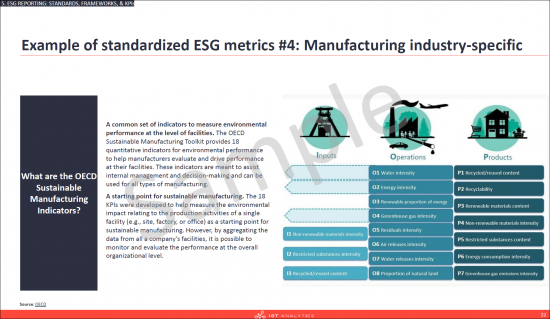
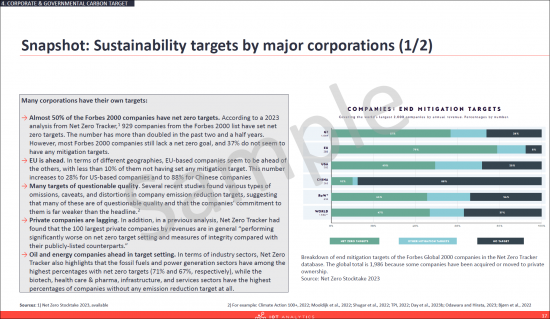
主な市場促進要因・課題・動向
IoT Analyticsは、5つの促進要因と7つの課題を特定しました。
持続可能性プラットフォームとは?
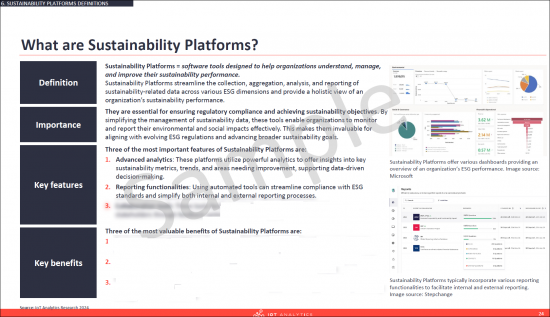
定義
持続可能性プラットフォームは、組織が持続可能性パフォーマンスを理解、管理、改善するために設計されたソフトウェアツールです。持続可能性プラットフォームは、ESGの様々な側面にわたる持続可能性関連データの収集、集計、分析、報告を合理化し、組織の持続可能性パフォーマンスを全体的に把握することができます。
分類
|
|
|
サンプルビュー
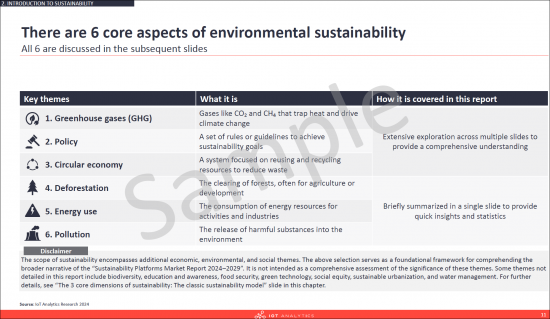
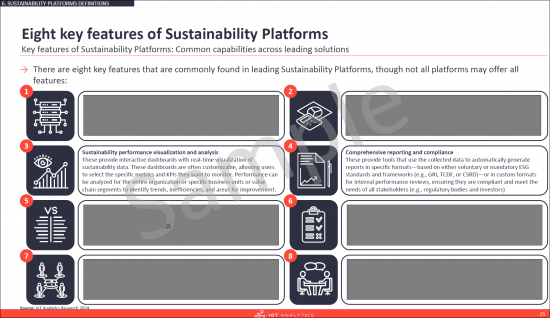
主な特徴
持続可能性プラットフォームの最も重要な特徴は以下の3つです:
- 1. 高度な分析:これらのプラットフォームは、強力なアナリティクスを活用して、主要な持続可能性指標、動向、改善が必要な領域に関する洞察を提供し、データ主導の意思決定をサポートします。
- 2. レポート機能:自動化されたツールを使用することで、ESG基準へのコンプライアンスを合理化し、社内外の報告プロセスを簡素化することができます。
- 3. コラボレーションツール:これらのツールは、フィードバックシステム、共有ダッシュボード、統合ワークフローを通じて、ステークホルダー間のコミュニケーションとエンゲージメントを促進します。
主なメリット
持続可能性プラットフォームの最も価値あるメリットは以下の3つです:
- 1. 規制遵守の容易化:ESGデータ管理とレポーティングを自動化することで、企業は進化する規制要件との整合性を保つことができます。
- 2. 意思決定の改善:データに基づく洞察により、企業はリスクと機会を特定し、リソースの使用を最適化してコストを削減する戦略を推進することができます。
- 3. 透明性とステークホルダーの関与:明確で利用しやすい情報を提供することで、ステークホルダーとの信頼関係を築き、責任ある行動へのコミットメントを示すことができ、組織の評判を高めることができます。
回答された質問
- 持続可能性プラットフォームとは何か
- 持続可能性プラットフォームの主な特徴と機能は何か
- 持続可能性プラットフォームの主要ベンダーはどこか
- 持続可能性プラットフォームの市場規模はどの程度か、また、どのようにセグメント (地域・産業別) に分かれているか
- 持続可能性プラットフォームを導入している企業のケーススタディにはどのようなものがあるか?
- ESGレポーティングはどのように機能するのか
- 政府や企業の持続可能性目標にはどのようなものがあるか
- 持続可能性とは何か
- 市場の主な推進要因と動向は何か
- 持続可能性マネジメントプラットフォームの採用における主要課題は何か
掲載企業
|
|
目次
第1章 エグゼクティブサマリー
第2章 持続可能性:イントロダクション
- 章の概要・重要ポイント
- 出発点:持続可能性は人類にとって最大の課題
- 近年「持続可能性」と「気候」に対する国民と企業の意識はともに高まっている
- 1) 持続可能性と2) 持続可能な開発の定義
- 持続可能性の3つの中核的側面:古典的な持続可能性モデル
- 「より強力な」持続可能性モデルは環境を第一に考える
- 世界の持続可能な開発の取り組みの進化における重要なマイルストーン
- 環境の持続可能性には6つの主要な側面
- 1.温室効果ガス
- 2.政策:国連の持続可能な開発目標
- 3.循環型経済
- 4.森林破壊
- 5.エネルギーの使用
- 6.汚染
- 持続可能性を高める方法:アナリストの主な見解
第3章 カーボンフットプリントと管理
- 章の概要・重要ポイント
- カーボンフットプリントとは何か?
- カーボンニュートラルとネットゼロの違い
- カーボンフットプリント計算のための3つの温室効果ガス排出範囲
- 企業が二酸化炭素排出量を削減する3つの主な方法
- 炭素価格
- スナップショット:世界各国の炭素価格設定の取り組みの概要
- ETSと炭素税の実例
- スナップショット:現在のETSと炭素税の価格動向
- 持続可能な開発開発その他の10の一般的な用語
第4章 企業と政府の二酸化炭素排出目標
- 章の概要・重要ポイント
- スナップショット:主要国政府の持続可能性目標
- スナップショット:主要都市の持続可能性目標
- スナップショット:大手企業の持続可能性目標
- 例1:Microsoft
- 例2:Apple
- 例3:Siemens
第5章 ESGレポーティング:基準、フレームワーク、KPI
- 章の概要・重要ポイント
- 環境、社会、ガバナンスに関する報告とその3つの側面
- ESGレポーティングの役割
- ESGと持続可能性の違い
- ESGデータの検証と保証
- ESGレポーティングのベストプラクティス
- ESG基準とフレームワークを理解する
- 4つの主要なESG標準化団体
- SBTi (The Science Based Targets initiative)
- ESG規制
- ESG規制:地域別概要
- ESGレポーティングの進化:世界基準の必要性を浮き彫りに
- ESG KPI:定義と役割
- 一般的ESG指標の概要
- 環境指標:説明・一般的KPI
- ソーシャルメトリック:説明と一般的KPI
- ガバナンス指標:説明と一般的KPI
- 標準化されたESG指標の例#1:ステークホルダーの資本主義指標
- 標準化されたESG指標の例#2:先進的製造業
- 標準化されたESG指標の例#3:モバイル業界
- 標準化されたESG指標の例#4:製造業
第6章 持続可能性プラットフォームの定義
- 章の概要・重要ポイント
- 持続可能性プラットフォームとは何か?
- 持続可能性プラットフォームの8つの主な特徴
- 持続可能性管理ソリューションの3つの主なカテゴリー
- 炭素管理プラットフォーム
- ESG管理および報告プラットフォーム
- サプライチェーンの持続可能性プラットフォーム
- 持続可能性プラットフォームの8つの主なメリット
- 3つの主な価格モデル
第7章 市場規模と展望
- 章の概要・重要ポイント
- この市場規模の焦点領域
- 世界の持続可能性プラットフォーム市場の推移・予測
- 持続可能性プラットフォーム市場:ベンダーシェア
- 世界の持続可能性プラットフォーム市場:地域別
- 世界の持続可能性プラットフォーム市場:北米
- 世界の持続可能性プラットフォーム市場:欧州
- 世界の持続可能性プラットフォーム市場:アジア太平洋
- 世界の持続可能性プラットフォーム市場:ラテンアメリカ
- 世界の持続可能性プラットフォーム市場:中東・アフリカ
- 世界の持続可能性プラットフォーム市場:ロシア・CIS
- 世界の持続可能性プラットフォーム市場:最大の国
- 世界の持続可能性プラットフォーム市場:業界別
- 世界の持続可能性プラットフォーム市場:顧客規模別
- 世界の持続可能性プラットフォーム市場:ソフトウェアタイプ別
第8章 競合情勢
- 章の概要・重要ポイント
- ベンダー情勢:ソリューションの焦点別
- ベンダー情勢:企業の重点分野別
- ベンダー情勢:企業の所在地別
- ベンダー情勢:企業規模別
- 過去3年間のSP企業の注目すべき買収
- ベンダー情勢:スタートアップ
- 最も資金提供を受けたSPスタートアップ
- 企業プロファイル:概要
- ベンダープロファイル:Microsoft
- ベンダープロファイル:SAP
- ベンダープロファイル:Salesforce
- ベンダープロファイル:IBM
- ベンダープロファイル:Sphera
- ベンダープロファイル:Persefoni
- ベンダープロファイル:Wolters Kluwer
- ベンダープロファイル:Workiva
- ベンダープロファイル:Watershed
- ベンダープロファイル:Sweep
- ベンダープロファイル:ServiceNow
- ベンダープロファイル:Cority
- ベンダープロファイル:Schneider Electric
- ベンダープロファイル:Siemens
第9章 促進要因、課題、動向
- 章の概要・重要ポイント
- 促進要因
- 課題
- 動向
第10章 調査手法
第11章 IoT Analyticsについて
A 219-page report on the market for sustainability software platforms for both carbon (footprint) management and ESG reporting (incl. market sizing, competitive landscape and key trends)
The "Sustainability Platforms Market Report 2025-2029" is part of IoT Analytics' ongoing coverage of emerging technology topics and vertical applications. The information presented in this report is based on the results of multiple surveys, secondary research as well as qualitative research, i.e., interviews with industry experts from vendors and end users. The document includes definitions for sustainability platforms, market projections, adoption drivers, competitive landscape, key trends and developments, and case studies.
SAMPLE VIEW



The main purpose of this document is to help our readers understand the current sustainability platform landscape by defining, sizing, and analyzing the market.
SAMPLE VIEW


About the market
The sustainability platform market is still at an early stage of development but growing rapidly. Most adopters are still at the pilot stage and/or with small-scale implementations. It is highly fragmented with eight main vendor types. Vendors are categorized into 8 segments:
|
|
SAMPLE VIEW


Key market drivers, challenges, and trends
IoT Analytics identified 5 drivers and 7 challenges highlighted in the report.
What are sustainability platforms?

Definition
Sustainability Platforms are software tools designed to help organizations understand, manage, and improve their sustainability performance. Sustainability Platforms streamline the collection, aggregation, analysis, and reporting of sustainability-related data across various ESG dimensions and provide a holistic view of an organization's sustainability performance.
Categorization
|
|
|
SAMPLE VIEW


Key features
Three of the most important features of Sustainability Platforms are:
- 1. Advanced analytics: These platforms utilize powerful analytics to offer insights into key sustainability metrics, trends, and areas needing improvement, supporting data-driven decision-making.
- 2. Reporting functionalities: Using automated tools can streamline compliance with ESG standards and simplify both internal and external reporting processes.
- 3. Collaboration tools: These tools facilitate communication and engagement among stakeholders through feedback systems, shared dashboards, and integrated workflows.
Key benefits
Three of the most valuable benefits of Sustainability Platforms are:
- 1. Easier regulatory compliance: Automating ESG data management and reporting ensures organizations stay aligned with evolving regulatory requirements.
- 2. Improved decision-making: Data-driven insights enable organizations to identify risks and opportunities, driving strategies that optimize resource use and reduce costs.
- 3. Transparency and stakeholder engagement: Providing clear, accessible information builds trust with stakeholders and demonstrates a commitment to responsible practices, enhancing an organization's reputation.
Questions answered:
- What are sustainability platforms (i.e., a definition)?
- What are the key features and capabilities of sustainability platforms, both for ESG reporting and for carbon management?
- Who are the leading vendors of sustainability platforms, and how much market share do they have?
- How large is the sustainability platforms market, and how does it split into segments (i.e., by regions or industries)?
- What are some insightful case studies of companies implementing sustainability platforms?
- How does ESG reporting work?
- What are some of the sustainability targets of governments and selected corporations?
- What is sustainability, and what are its various aspects?
- What are the key drivers and trends in the market?
- What are the key challenges to sustainability management platform adoption?
Companies mentioned:
A selection of companies mentioned in the report.
|
|
Table of Contents
1. Executive Summary
2. Introduction to sustainability
- Introduction to sustainability: Chapter overview and key takeaways
- Starting point: Becoming sustainable is a top challenge for humanity
- Both public and corporate awareness of "sustainability" and "climate" have jumped in recent years
- Defining 1) sustainability and 2) sustainable development
- The 3 core dimensions of sustainability: The classic sustainability model
- The "stronger" sustainability model puts the environment first
- Key milestones in the evolution of global sustainable development efforts
- There are 6 core aspects of environmental sustainability
- 1. Greenhouse gases: Overview
- 1. Greenhouse gases: What they are
- 1. Greenhouse gases: The nine main types of gases
- 1. Greenhouse gases: Main contributors to GHG emissions
- 1. Greenhouse gases: Emissions by sector
- 1. Greenhouse gases: Fossil fuel company emissions
- 1. Greenhouse gases: The Greenhouse effect
- 1. Greenhouse gases: The effect on climate change
- 2. Policy: The UN Sustainable Development Goals
- 2. Policy: The UN Sustainable Development - goals
- 2. Policy: The UN Sustainable Development - current progress
- 2. Policy: The Paris Agreement - overview
- 2. Policy: The Paris Agreement - current status
- 3. Circular economy: Overview
- 3. Circular economy: Key benefits
- 3. Circular economy: Key challenges
- 3. Circular economy: The role of technology
- 3. Circular economy: Daisy helps Apple battle e-waste
- 3. Circular economy: Life cycle assessment
- 4. Deforestation
- 5. Energy use
- 6. Pollution
- How to become more sustainable: Key analyst viewpoints
3. Carbon footprint and management
- Carbon footprint and management: Chapter overview and key takeaways
- What is a carbon footprint?
- The difference between Carbon Neutral and Net Zero
- Three GHG emission scopes for carbon footprint calculations
- Three main ways for companies to reduce their carbon footprint
- Carbon pricing
- Snapshot: Overview of carbon pricing initiatives around the world
- Practical examples of ETS and carbon taxes
- Snapshot: Current ETS and Carbon Taxes pricing trends
- Ten other common sustainable development terms
4. Corporate and governmental carbon footprint targets
- Corporate and governmental carbon footprint targets: Chapter overview and key takeaways
- Snapshot: Sustainability targets by major governments
- Snapshot: Sustainability targets by major cities
- Snapshot: Sustainability targets by major corporations
- Example 1: Microsoft's commitment to sustainability
- Example 1: Microsoft's mission to become carbon negative by 2030
- Example 2: Apple's commitment to sustainability
- Example 2: Apple 2030-Apple's journey to carbon neutrality by 2030
- Example 3: Siemens' commitment to sustainability
5. ESG reporting: Standards, frameworks, KPIs
- ESG reporting - Standards, frameworks, & KPIs: Chapter overview and key takeaways
- Environment, social, and governance reporting and its three dimensions
- The role of ESG reporting
- The difference between ESG and sustainability
- ESG data verification and assurance
- Best practices for ESG reporting
- Understanding ESG standards and frameworks
- There are currently 4 major ESG standards organizations
- These are the four most commonly used ESG frameworks
- The Science Based Targets initiative (SBTi)
- ESG regulations
- ESG regulations: Regional overview
- Deep Dive: Two key ESG reporting regulations in EU and US
- The evolution of ESG reporting highlights the need for global standards
- ESG KPIs: Definition and role
- Overview of common ESG metrics
- Environmental metrics: Description and common KPIs
- Social metrics: Description and common KPIs
- Governance metrics: Description and common KPIs
- Example of standardized ESG metrics #1 : Stakeholder capitalism metrics
- Example of standardized ESG metrics #2: Advanced manufacturing-specific
- Example of standardized ESG metrics #3: Mobile industry-specific
- Example of standardized ESG metrics #4: Manufacturing industry-specific
6. Sustainability platforms definition
- Sustainability Platforms definitions & segmentation: Chapter overview and key takeaways
- What are Sustainability Platforms?
- Eight key features of Sustainability Platforms
- Three main categories of sustainability management solutions
- Carbon management platforms
- ESG management and reporting platforms
- Supply chain sustainability platforms
- Eight key benefits of Sustainability Platforms
- Three main pricing models
7. Market size and outlook
- Introduction: Chapter overview and key takeaways
- Focus area of this market sizing
- Global Sustainability Platforms Market 2022-2029
- Sustainability Platform market: Vendor shares 2023
- Global Sustainability Platform market: By region
- Global Sustainability Platform market: North America
- Global Sustainability Platform market: Europe
- Global Sustainability Platform market: Asia-Pacific
- Global Sustainability Platform market: Latin America
- Global Sustainability Platform market: Middle East & Africa
- Global Sustainability Platform market: Russia & CIS
- Global Sustainability Platform market: Largest countries
- Global Sustainability Platform market: By industry
- Global Sustainability Platform market: By customer size
- Global Sustainability Platform market: By software type
8. Competitive landscape
- Introduction: Chapter overview and key takeaways
- Vendor landscape: By solution focus
- Vendor landscape: By company focus
- Vendor landscape: By company location
- Vendor landscape: By company size
- Noticeable acquisitions of SP companies in the past 3 years
- Vendor landscape: Start-ups
- Most funded SP start-ups
- Company Profiles: Overview
- Vendor profile: Microsoft
- Vendor Profile: SAP
- Vendor Profile: Salesforce
- Vendor Profile: IBM
- Vendor Profile: Sphera
- Vendor Profile: Persefoni
- Vendor Profile: Wolters Kluwer
- Vendor Profile: Workiva
- Vendor Profile: Watershed
- Vendor Profile: Sweep
- Vendor Profile: ServiceNow
- Vendor Profile: Cority
- Vendor Profile: Schneider Electric
- Vendor Profile: Siemens
9. Drivers, challenges and trends
- Introduction: Chapter overview and key takeaways
- Drivers: Overview
- Drivers
- Challenges: Overview
- Challenges
- Trends and developments: Overview
- Trends and developments
